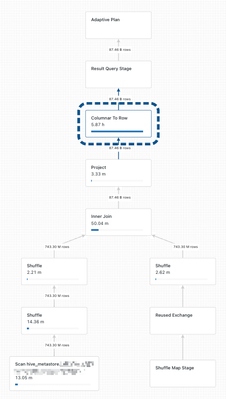I am running a relatively simple SQL query that writes back to a table on a Databricks serverless SQL warehouse, and I'm trying to understand why there is a "Columnar To Row" node in the query profile that is consuming the vast majority of the time spent executing the query. The rest of the query plan makes sense to me, but I can't figure out why it would need to convert to row format if the query is just writing back to another table - shouldn't it stay entirely in columnar format? Maybe I'm misunderstanding the purpose of this node...

CREATE
OR REPLACE TABLE id_mappings AS
select
l.id_current as id_old,
r.id_current as id_new
from
tuples as l
join tuples as r on (l.`HashedEmail` = r.`HashedEmail`)
where
l.id_current > r.id_current
and l.`HashedEmail` is not null
and r.`HashedEmail` is not null
and l.`HashedEmail` != ''
and r.`HashedEmail` != ''